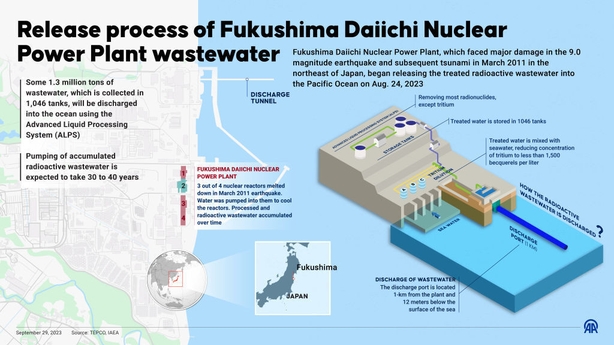Japan has begun releasing the second batch of treated wastewater from the Fukushima nuclear plant, an incremental step in a decades-long process that has drawn strong condemnation from China.
The discharge involves a small portion of the 1.34 million tonnes of wastewater built up since a tsunami struck the facility in 2011.
While Japan has insisted the treated water poses no health risks - a view backed by the United Nation's nuclear watchdog - China has repeatedly criticised the release and banned all Japanese seafood imports in response.
As with the initial release that began on 24 August, about 7,800 tonnes of water is expected to be discharged over 17 days.
The plant's operator TEPCO said the wastewater has been filtered of all radioactive elements except tritium, which is within internationally recognised safe levels.
"It has been confirmed that the first release has been conducted as planned and in a safe manner," government spokesman Hirokazu Matsuno said, stressing no abnormalities had been detected.
The government will "continue to communicate, both domestically and internationally, results of monitoring data in a highly transparent manner", Mr Matsuno added.
Japan is also urging China to "immediately scrap import bans on Japanese food, and act based on scientific justifications", he said.
Russia, which has frosty relations of its own with Japan, is reportedly considering following suit on the seafood ban.
Food exports from Japan to China fell by 41.2% percent in August, according to finance ministry data.

China has accused Japan of using the ocean like a "sewer", an assertion echoed at the UN last week by Solomon Islands Prime Minister Manasseh Sogavare, whose close ties with Beijing have drawn alarm from traditional Western allies such as Australia.
Following August's initial release, numerous Japanese businesses reported having trouble conducting daily operations after being flooded with angry calls from Chinese numbers.
Meanwhile, Tokyo demanded that China ensure the safety of Japanese citizens after a brick was thrown at its embassy in Beijing.
Read more:
Water samples after Fukushima release 'safe' - operator
China bans Japanese seafood after Fukushima release
The release of wastewater is aimed at making space to eventually begin removing highly dangerous radioactive fuel and rubble from the plant's wrecked reactors.
TEPCO will be rigorous in overseeing the second round, an official said, while exercising "the utmost vigilance to ensure that there is no unintentional discharge" of treated water into the sea.

